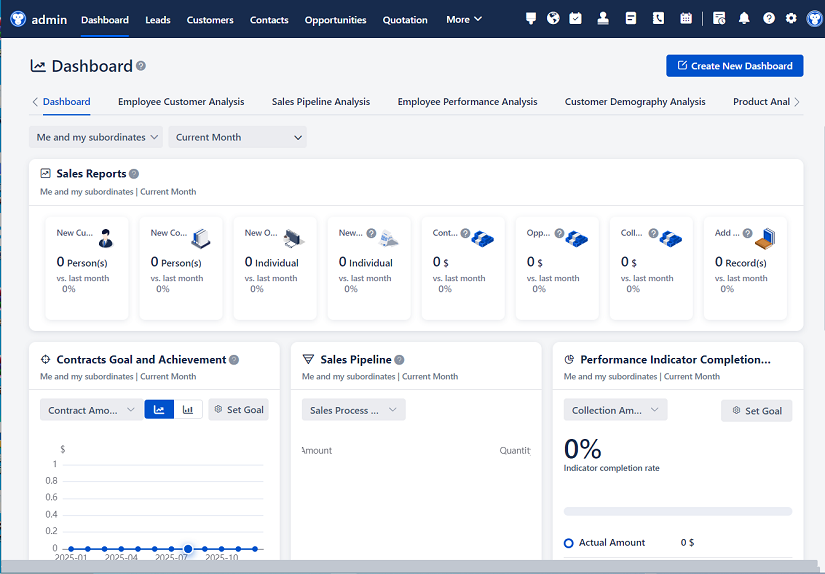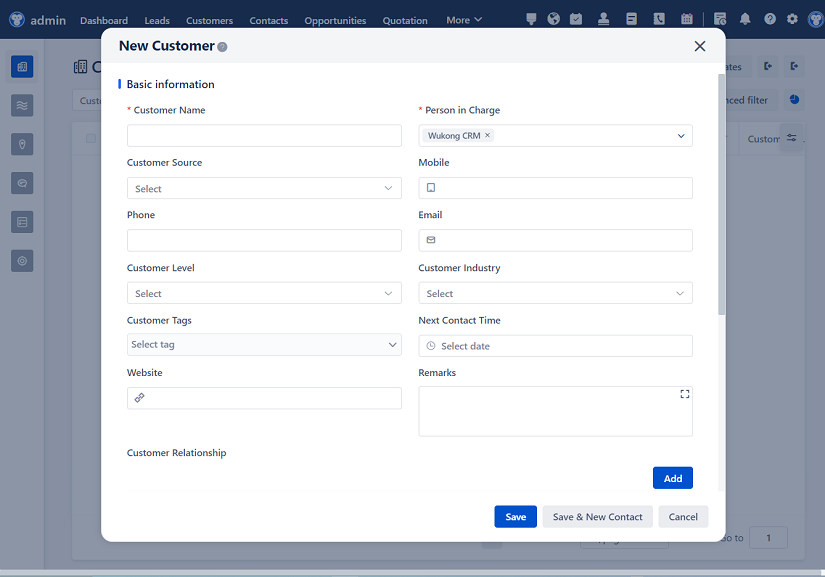
△Click on the top right corner to try Wukong CRM for free
So, I’ve been thinking a lot about how we’ve been using our CRM system lately, and honestly, it’s kind of been a rollercoaster. At first, when we rolled it out, there was this big push—everyone was excited, management was hyped, and we all got trained on the new platform. But you know how it is—after the initial buzz wears off, things tend to settle into routines, for better or worse.
Let me tell you, getting everyone on board wasn’t easy. Some people loved it right away—they saw how much easier it was to track leads, log calls, and set follow-ups. But others? They were dragging their feet. I remember one guy in sales saying, “I don’t need a computer telling me who to call—I’ve been doing this for 15 years.” Classic resistance to change, right?
Free use of CRM system: Free CRM
Still, we pushed through because the benefits were just too good to ignore. For starters, having all customer data in one place changed everything. Before, if someone left the company, their contacts and notes would basically vanish. Now? Everything’s documented. It’s like having institutional memory that doesn’t walk out the door.
And let’s talk about efficiency. I used to spend hours digging through old emails or spreadsheets trying to find a client’s last order or preferences. Now, with the CRM, I just type in their name and boom—everything’s right there. It saves so much time, especially during busy seasons.
Another thing I really appreciate is the automation. Setting up reminders for follow-ups, sending personalized email sequences, even tracking when someone opens an email—it’s like having a tiny assistant working 24/7. I don’t have to worry about dropping the ball with a hot lead anymore.
But here’s the thing—not every feature gets used equally. We paid for this fancy analytics dashboard, but half the team doesn’t even know how to access it. And the reporting tools? Super powerful, sure, but only if you actually use them. I’ve had to nudge my manager more than once to check the monthly sales pipeline report.
Training has definitely been a weak spot. Yeah, we had that one-day session when we launched, but after that? Crickets. People forget things, especially if they’re not using a feature regularly. I’ve seen teammates manually entering data that could’ve been imported in seconds—just because they didn’t know how.
And then there’s data quality. That’s a big one. The CRM is only as good as the info you put in. If someone skips filling out a field or enters garbage data, it messes up reports and makes forecasting a nightmare. I’ve caught duplicate entries, wrong phone numbers, even fake names (looking at you, “John Doe” from marketing).
We tried enforcing rules—like making certain fields mandatory—but that just led to people rushing through and typing nonsense to get past the form. So now we’re stuck between bad data and annoyed users. Not ideal.
On the bright side, collaboration has improved. Before, if two people were working on the same account, there was zero visibility. Now, we can see each other’s notes, tasks, and interactions. It’s helped reduce double-contacting clients, which customers definitely appreciate.
Integration with other tools has been a game-changer too. Linking the CRM to our email, calendar, and even our billing software means less switching between apps. I can schedule a meeting, send a proposal, and update the deal stage—all without leaving the CRM. That kind of seamless workflow? Huge.
Customer service has gotten better as well. When a support ticket comes in, the agent can pull up the full history instantly—past purchases, complaints, even personal details like birthdays or pet names. It makes the interaction feel way more human, even though it’s tech-driven.
Sales managers love the visibility now. They can see real-time pipelines, track individual performance, and spot bottlenecks early. One manager told me he caught a rep who hadn’t logged any calls in a week—turned out the guy was overwhelmed and needed help. Without the CRM, that might’ve gone unnoticed for months.
Forecasting has become way more accurate too. Instead of guessing based on gut feeling, we can look at historical conversion rates, average deal size, and sales cycle length. It’s made budget planning and goal setting way more realistic.
But—and this is a big but—the system isn’t perfect. Sometimes it feels clunky. The interface isn’t always intuitive, and loading times can be frustrating, especially when you’re in a hurry. I’ve lost count of how many times I’ve clicked “save” and nothing happened for 10 seconds.

Mobile access is okay, but not great. Sure, there’s an app, but some features are missing or glitchy. I tried updating a contact while on a client site last week, and the app crashed twice. Not exactly professional when you’re standing in front of a customer.
Customization is another mixed bag. We’ve tailored some fields and workflows to fit our process, which is great. But every time we want to make a change, it takes forever because only the IT admin can do it. And don’t get me started on the approval process for updates.
User adoption is still uneven. About 70% of the team uses it consistently and well. Another 20% use it occasionally but miss key features. And the remaining 10%? They treat it like a chore—logging in only when forced. That creates gaps in our data and limits what we can do as a team.

We did try incentives—like a “Top CRM User of the Month” award with a gift card. It helped a little, but honestly, people care more about hitting quotas than filling out forms. Unless using the CRM directly helps them close deals, motivation stays low.
One thing that’s worked better is peer influence. When newer reps see top performers using the CRM effectively—logging every touchpoint, tagging deals correctly, using templates—they start mimicking those habits. Culture matters more than policies sometimes.
We also realized that leadership needs to model good behavior. When our VP started sharing insights from CRM reports in team meetings, attendance to those meetings went up. People pay attention when they see the boss using the tool seriously.
Data security is something we take seriously too. The CRM has role-based permissions, so not everyone sees everything. Finance can view payment history but not marketing notes, for example. That keeps things clean and compliant.
Backup and recovery have been solid. We had a minor server hiccup last quarter, but all data was restored within hours. That gave everyone peace of mind—especially legal, who freaks out about compliance.
Looking ahead, we’re exploring AI-powered features. There’s talk about adding predictive lead scoring or chatbot integrations. Sounds cool, but I’m cautious. Fancy tech is great, but only if it solves real problems.

We’re also considering quarterly refresher trainings. Not long sessions—maybe 90 minutes every three months to review best practices, answer questions, and show off underused features. Small investments like that could boost adoption.
Feedback loops are important too. We set up a simple survey asking what people love and hate about the CRM. The responses were eye-opening. Turns out, the biggest complaint wasn’t the software—it was lack of time to use it properly. That’s on us as a company, not the tool.
So overall, I’d say the CRM has been a net positive. It hasn’t fixed every problem, and it’s definitely not magic. But it’s made us more organized, more transparent, and more customer-focused. And honestly, that’s worth the growing pains.
Would I recommend a CRM to another company? Absolutely—but with caveats. It’s not just about buying software. It’s about changing habits, investing in training, and committing to data hygiene. Without that, even the fanciest CRM will collect digital dust.
And hey, maybe one day we’ll actually get that voice-to-text integration we keep asking for. A person can dream, right?
FAQs (Frequently Anticipated Questions):
Q: What’s the biggest benefit you’ve seen from using the CRM?
A: Honestly? Centralized customer data. No more chasing down info across emails, sticky notes, or someone’s personal spreadsheet. Everything’s in one place, and that saves so much time.
Q: Did everyone on your team adapt quickly?
Not at all. Some jumped right in, but others resisted hard. It took months of encouragement, training, and showing real examples of how it helps to get most people on board.
Q: How do you handle poor data entry?
It’s tough. We’ve tried mandatory fields, audits, and even light accountability in team meetings. The best fix? Leadership modeling good behavior and making data quality part of performance reviews.
Q: Is the CRM expensive?
It’s not cheap, but we see it as an investment. When you factor in time saved, fewer missed opportunities, and better customer retention, it pays for itself pretty fast.
Q: Can small teams benefit from a CRM too?
Absolutely. In fact, smaller teams might benefit even more because they can’t afford to lose a single lead or customer detail. Just pick a simpler, scalable system.
Q: What should companies avoid when implementing a CRM?
Don’t treat it like a one-and-done project. Rolling it out is just the beginning. Ongoing training, feedback, and process tweaks are crucial. Also, don’t overload it with unnecessary customizations early on.

Q: How often should you review CRM usage?
We do quick check-ins monthly and deeper reviews every quarter. It helps catch issues early and keeps the team engaged with the system.
Q: Any tips for improving user adoption?
Start with your influencers—get your top performers using it well, and others will follow. Make it relevant: show how it helps them save time or close more deals. And keep training simple and practical.
Q: Does the CRM replace personal relationships with customers?
No way. It supports them. The CRM gives you the facts and reminders, but the relationship-building still comes from genuine conversations and trust. Tech enhances humans—it doesn’t replace them.
Q: What’s one feature you couldn’t live without now?
Automated follow-up sequences. I set them up once, and they keep leads warm without me lifting a finger. It’s like autopilot for nurturing.
Related links:
Free trial of CRM
Understand CRM software

△Click on the top right corner to try Wukong CRM for free